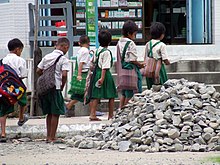Main article: Health in Burma
Further information: HIV/AIDS in Burma
The general state of health care in Myanmar (Burma) is poor. The
government spends anywhere from 0.5% to 3% of the country's GDP on
health care, consistently ranking among the lowest in the world.[289][290]
Although health care is nominally free, in reality, patients have to
pay for medicine and treatment, even in public clinics and hospitals.
Public hospitals lack many of the basic facilities and equipment.HIV/AIDS, recognised as a disease of concern by the Burmese Ministry of Health, is most prevalent among sex workers and intravenous drug users. In 2005, the estimated adult HIV prevalence rate in Burma was 1.3% (200,000–570,000 people), according to UNAIDS, and early indicators of any progress against the HIV epidemic are inconsistent.[291][292][293] However, the National AIDS Programme Burma found that 32% of sex workers and 43% of intravenous drug users in Burma have HIV.[293]
Burma's government spends the least percentage of its GDP on health care of any country in the world, and international donor organisations give less to Burma, per capita, than any other country except India.[294] According to the report named "Preventable Fate", published by Doctors without Borders, 25,000 Burmese AIDS patients died in 2007, deaths that could largely have been prevented by antiretroviral therapy drugs and proper treatment.[294]
In June 2011, the United Nations Population Fund released a report on The State of the World's Midwifery. It contained new data on the midwifery workforce and policies relating to newborn and maternal mortality for 58 countries. The 2010 maternal mortality rate per 100,000 births for Myanmar is 240. This is compared with 219.3 in 2008 and 662 in 1990. The under 5 mortality rate, per 1,000 births is 73 and the neonatal mortality as a percentage of under 5's mortality is 47.
Education
Main article: Education in Burma
The educational system of Burma is operated by the government agency, the Ministry of Education.
Universities and professional institutes from upper Burma and lower
Burma are run by two separate entities, the Department of Higher
Education of Upper Burma and the Department of Higher Education of Lower
Burma. Headquarters are based in Yangon and Mandalay respectively. The
education system is based on the United Kingdom's system, due to nearly a
century of British and Christian presences in Burma. Nearly all schools
are government-operated, but there has been a recent increase in
privately funded English language schools. Schooling is compulsory until
the end of elementary school, probably about 9 years old, while the
compulsory schooling age is 15 or 16 at international level.There are 101 universities, 12 institutes, 9 degree colleges and 24 colleges in Burma, a total of 146 higher education institutions.[295]
There are 10 Technical Training Schools, 23 nursing training schools, 1 sport academy and 20 midwifery schools.
There are 2047 Basic Education High Schools, 2605 Basic Education Middle Schools, 29944 Basic Education Primary Schools and 5952 Post Primary Schools. 1692 multimedia classrooms exist within this system.
There are four international schools acknowledged by WASC and College Board—The International School Yangon (ISY), Crane International School Yangon (CISM), Yangon International School (YIS) and International School of Myanmar (ISM) in Yangon.


Tidak ada komentar:
Posting Komentar